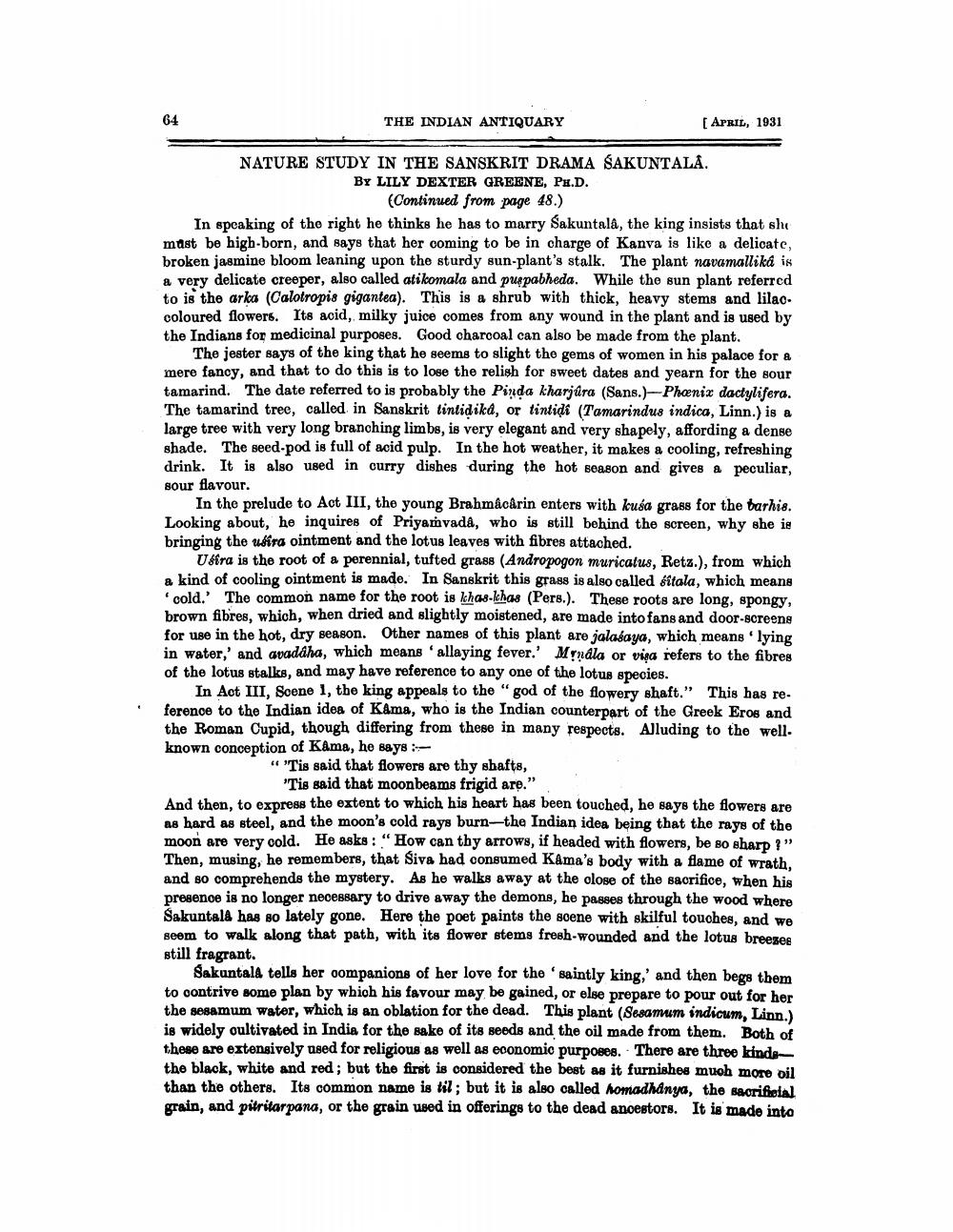________________
64
THE INDIAN ANTIQUARY
APRIL, 1931
NATURE STUDY IN THE SANSKRIT DRAMA SAKUNTALA.
BY LILY DEXTER GREENE, PH.D.
(Continued from page 48.) In speaking of the right he thinks he has to marry Sakuntala, the king insists that she must be high-born, and says that her coming to be in charge of Kanva is like a delicate, broken jasmine bloom leaning upon the sturdy sun-plant's stalk. The plant navamallika is a very delicate creeper, also called atikomala and puspabheda. While the sun plant referred to is the arka (Calotropis gigantea). This is a shrub with thick, heavy stems and lilao. coloured flowers. Its acid, milky juice comes from any wound in the plant and is used by the Indians for medicinal purposes. Good charcoal can also be made from the plant.
The jester says of the king that he seems to slight the gems of women in his palace for a mere fancy, and that to do this is to lose the relish for sweet dates and yearn for the sour tamarind. The date referred to is probably the Pinda kharjúra (Sans.)--Phoenix dactylifera. The tamarind tree, called in Sanskrit tintidikd, or tintidi (Tamarindus indica, Linn.) is a large tree with very long branching limbs, is very elegant and very shapely, affording a dense shade. The seed-pod is full of acid pulp. In the hot weather, it makes a cooling, refreshing drink. It is also used in curry dishes during the hot season and gives a peculiar, sour flavour.
In the prelude to Act III, the young Brahmâcárin enters with kusa grass for the darhis. Looking about, he inquires of Priyamvada, who is still behind the screen, why she is bringing the ubira ointment and the lotus leaves with fibres attached.
Uffra is the root of a perennial, tufted grass (Andropogon muricatus, Retz.), from which a kind of cooling ointment is made. In Sanskrit this grass is also called sitala, which means
cold.' The common name for the root is khas-khas (Pers.). These roots are long, spongy, brown fibres, which, when dried and slightly moistened, are made into fans and door-screens for use in the hot, dry season. Other names of this plant are jalasaya, which means 'lying in water,' and avaddha, which means 'allaying fever.' Myndla or via refers to the fibres of the lotus stalks, and may have reference to any one of the lotus species.
In Act III, Soene 1, the king appeals to the "god of the flowery shaft." This has reference to the Indian idea of Kama, who is the Indian counterpart of the Greek Eros and the Roman Cupid, though differing from these in many respects. Alluding to the well. known conception of Kama, he says -
« 'Tis said that flowers are thy shafts,
"Tis said that moonbeams frigid are." And then, to express the extent to which his heart has been touched, he says the flowers are as hard as steel, and the moon's cold rays burn-the Indian idea being that the rays of the moon are very cold. He asks: "How can thy arrows, if headed with flowers, be so sharp ?" Then, musing, he remembers, that Siva had consumed Kama's body with a flame of wrath. and so comprehends the mystery. As he walks away at the close of the sacrifice, when his presence is no longer necessary to drive away the demons, he passes through the wood where Sakuntala has so lately gone. Here the poet paints the soene with skilful touches, and we seem to walk along that path, with its flower stems fresh-wounded and the lotus breezes still fragrant.
Sakuntala tells her companions of her love for the saintly king,' and then begs them to contrive some plan by which his favour may be gained, or else prepare to pour out for her the sesamum water, which is an oblation for the dead. This plant (Sesamum indicum, Linn.) is widely oultivated in India for the sake of its seeds and the oil made from them. Both of these are extensively used for religious as well as economic purposes. There are three kinde the black, white and red; but the first is considered the best as it furnishes muoh more oil than the others. Its common name is til; but it is also called homadhanya, the sacrificial grain, and pitritarpana, or the grain used in offerings to the dead ancestors. It is made into




